I ruderi del Castello Vecchio che si ergono sugli scogli a livello del mare e le prime citazioni storiche del vecchio maniero sono di Plinio il Vecchio che menziona la costruzione originaria, nominata Castellum Pucinum, eretta sull’aspro promontorio tra Monfalcone e Trieste, dove precedentemente – secondo la tradizione – si trovava un luogo di culto druidico dedicato al Dio Sole. Il primo nucleo fortificato che diede forma e vita al borgo, sorse nel XI sec.
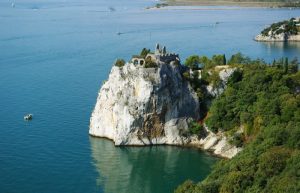
Testimonianza ne dà il più antico documento scritto che tratta della rocca di Duino datato 1139, periodo in cui iniziò il dominio dei Tybein de Dewino (o Tybeiner) vassalli dei patriarchi di Aquileia. Anche la località, allora, era chiamata Tybein. Il feudo era reso immune agli attacchi dall’alta cinta merlata e dalla vista che permetteva un controllo sull’arrivo di navi nemiche.
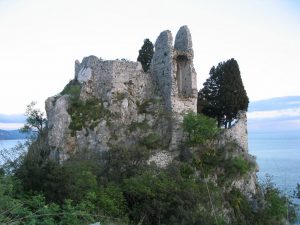
Alla rocca si poteva accedere per un unico sentiero impervio e fortificato lungo il muro di cinta. La torre era costituita da differenti piani. Dai resti ritrovati, come un leggio incastonato nella parete vicino ad una finestra ogivale e dagli affreschi rimasti nel piano inferiore, si è supposto che questo ultimo fosse adibito a cappella, mentre quelli superiori servirono a lungo come prigione. Un ponte levatoio si trovava dove oggi è posto l’ingresso alla rocca.
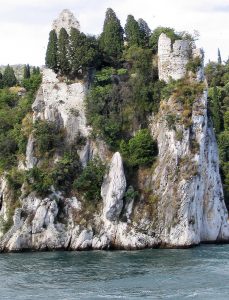
Al Castello vecchio di Duino è legata la leggenda della “dama bianca” ispirata ad una roccia bianca che, vista dal mare, sembra una figura femminile avvolta da un velo.Si racconta che un tempo il castello era abitato da un cavaliere malvagio che infastidito dall’animo generoso e buono della sua sposa di nome Esterina da Portole escogitò un piano per ucciderla. Una notte l’attirò su un setiero stretto intorno alle mura del castello e la gettò in mare.La donna sconvolta e atterrita lanciò un urlo soffocato e rimase pietrificata. Si racconta che da quel giorno durante la notte la dama si stacca dalla roccia e girovaga nel castello,attraversando tutte le sale fino alla stanza dove dormiva il suo bambino e lì rimane fino all’alba per poi tornare alla roccia dove il suo dolore la trasforma di nuovo in pietra.
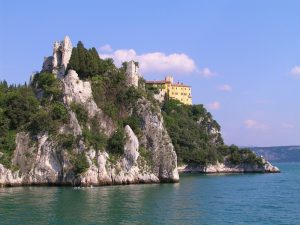 Un’altra leggenda racconta che nei sotterranei del Castello Vecchio era stata imprigionata Antonia una dolce fanciulla che si era innamorata di un uomo che sembrava un benefattore ma che in realtà era uno spietato e crudele assassino, Giovanni Sbogar. Purtoppo quando lei lo scoprì era stata derubata e aggredita dai suoi scagnozzi, impazzì dal dolore e si rinchiuse in un convento.
Un’altra leggenda racconta che nei sotterranei del Castello Vecchio era stata imprigionata Antonia una dolce fanciulla che si era innamorata di un uomo che sembrava un benefattore ma che in realtà era uno spietato e crudele assassino, Giovanni Sbogar. Purtoppo quando lei lo scoprì era stata derubata e aggredita dai suoi scagnozzi, impazzì dal dolore e si rinchiuse in un convento.
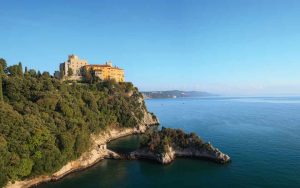
Triesteracconta che al Castelvecchio di Duino abbia soggiornato Dante Alighieri durante il periodo dell’esilio e che alcuni versi della Divina Commedia siano stati scritti dal poeta proprio osservando il panorama di Duino da uno scoglio che è situato tra il castello vecchio e quello nuovo e per questo motivo è detto: lo scoglio di Dante. La principessa Teresa Thurn-Hohenlohe dedicò un poemetto a questa leggenda:“Ma qual fu quell’ora armonica che all’Altissimo Poeta echeggiò per l’ onda cheta Allorché peregrinando Dalla cieca patria in bando, su quel scoglio si fermò E di là con mente fervida, guardò a Pola ed al Quarnaro Forse fu quel tocco flebile, ch’ esortando alla preghiera pei fratelli in altra sfera, Il suo spirito credente avviò pel regno ardente, pel purgante insino al ciel”
 Un’altra leggenda racconta che nei sotterranei del Castello Vecchio era stata imprigionata Antonia una dolce fanciulla che si era innamorata di un uomo che sembrava un benefattore ma che in realtà era uno spietato e crudele assassino, Giovanni Sbogar. Purtoppo quando lei lo scoprì era stata derubata e aggredita dai suoi scagnozzi, impazzì dal dolore e si rinchiuse in un convento.
Un’altra leggenda racconta che nei sotterranei del Castello Vecchio era stata imprigionata Antonia una dolce fanciulla che si era innamorata di un uomo che sembrava un benefattore ma che in realtà era uno spietato e crudele assassino, Giovanni Sbogar. Purtoppo quando lei lo scoprì era stata derubata e aggredita dai suoi scagnozzi, impazzì dal dolore e si rinchiuse in un convento.




